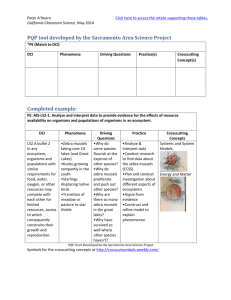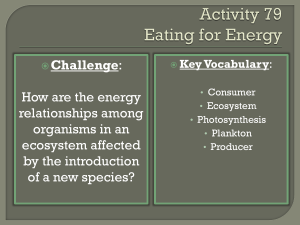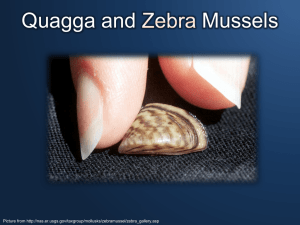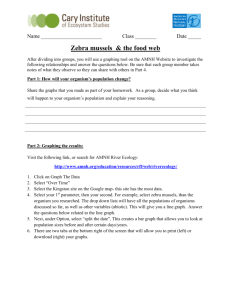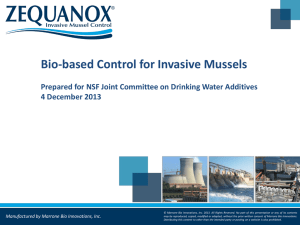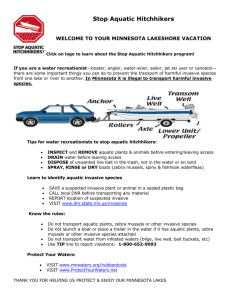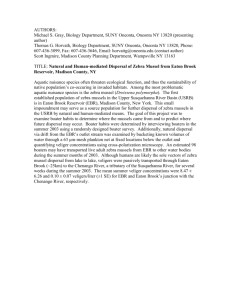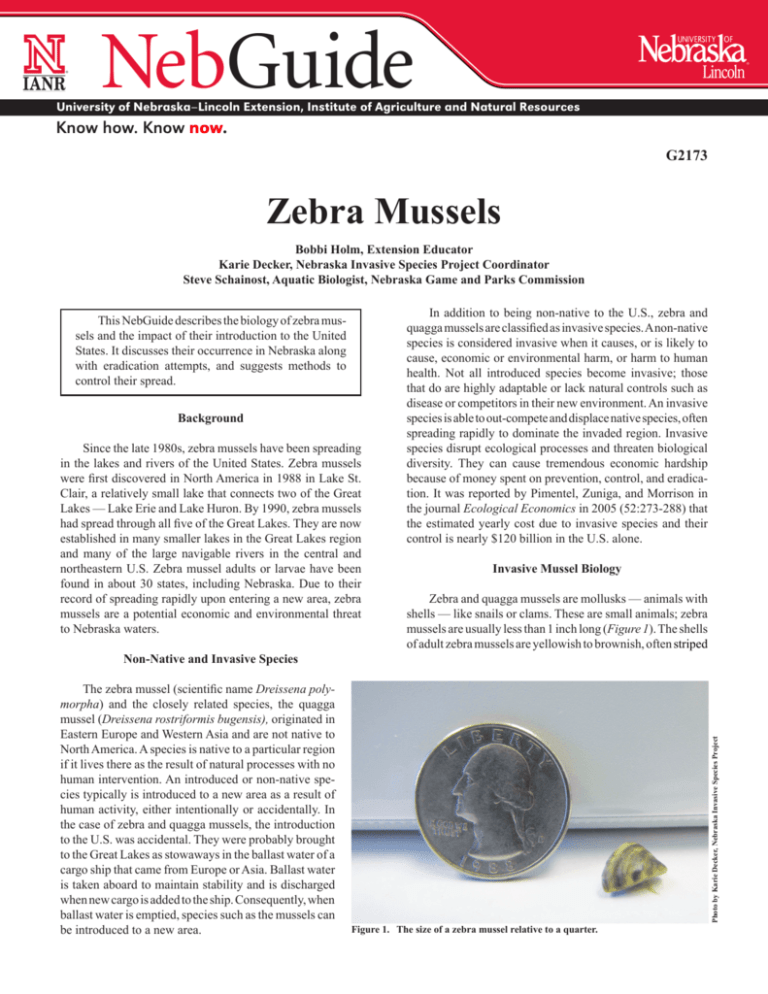
®
®
University of Nebraska–Lincoln Extension, Institute of Agriculture and Natural Resources
Know how. Know now.
G2173
Zebra Mussels
Bobbi Holm, Extension Educator
Karie Decker, Nebraska Invasive Species Project Coordinator
Steve Schainost, Aquatic Biologist, Nebraska Game and Parks Commission
Background
Since the late 1980s, zebra mussels have been spreading
in the lakes and rivers of the United States. Zebra mussels
were first discovered in North America in 1988 in Lake St.
Clair, a relatively small lake that connects two of the Great
Lakes — Lake Erie and Lake Huron. By 1990, zebra mussels
had spread through all five of the Great Lakes. They are now
established in many smaller lakes in the Great Lakes region
and many of the large navigable rivers in the central and
northeastern U.S. Zebra mussel adults or larvae have been
found in about 30 states, including Nebraska. Due to their
record of spreading rapidly upon entering a new area, zebra
mussels are a potential economic and environmental threat
to Nebraska waters.
Non-Native and Invasive Species
The zebra mussel (scientific name Dreissena polymorpha) and the closely related species, the quagga
mussel (Dreissena rostriformis bugensis), originated in
Eastern Europe and Western Asia and are not native to
North America. A species is native to a particular region
if it lives there as the result of natural processes with no
human intervention. An introduced or non-native species typically is introduced to a new area as a result of
human activity, either intentionally or accidentally. In
the case of zebra and quagga mussels, the introduction
to the U.S. was accidental. They were probably brought
to the Great Lakes as stowaways in the ballast water of a
cargo ship that came from Europe or Asia. Ballast water
is taken aboard to maintain stability and is discharged
when new cargo is added to the ship. Consequently, when
ballast water is emptied, species such as the mussels can
be introduced to a new area.
In addition to being non-native to the U.S., zebra and
quagga mussels are classified as invasive species. A non-native
species is considered invasive when it causes, or is likely to
cause, economic or environmental harm, or harm to human
health. Not all introduced species become invasive; those
that do are highly adaptable or lack natural controls such as
disease or competitors in their new environment. An invasive
species is able to out-compete and displace native species, often
spreading rapidly to dominate the invaded region. Invasive
species disrupt ecological processes and threaten biological
diversity. They can cause tremendous economic hardship
because of money spent on prevention, control, and eradication. It was reported by Pimentel, Zuniga, and Morrison in
the journal Ecological Economics in 2005 (52:273-288) that
the estimated yearly cost due to invasive species and their
control is nearly $120 billion in the U.S. alone.
Invasive Mussel Biology
Zebra and quagga mussels are mollusks — animals with
shells — like snails or clams. These are small animals; zebra
mussels are usually less than 1 inch long (Figure 1). The shells
of adult zebra mussels are yellowish to brownish, often striped
Figure 1. The size of a zebra mussel relative to a quarter.
Photo by Karie Decker, Nebraska Invasive Species Project
This NebGuide describes the biology of zebra mussels and the impact of their introduction to the United
States. It discusses their occurrence in Nebraska along
with eradication attempts, and suggests methods to
control their spread.
Photo by Karie Decker, Nebraska Invasive Species Project
Figure 2. When viewed from the side, Zebra mussel shells are D-shaped.
in a dark and light pattern, hence the name zebra mussels.
They can also have shells without stripes. The underside of
the shell is flat and when the mussel is seen from the side, you
notice the “D-shaped” shell (Figure 2). Quagga mussels are a
little larger and rounder, and do not have flat-bottomed shells.
Zebra and quagga mussel populations can increase very
quickly, compounding their threat as an invasive species.
Spawning usually takes place in the spring and summer but
can occur year-round where water temperatures are warm
(above 50°F). A female produces up to 40,000 eggs in a reproductive cycle. Under the right conditions, one female can
produce up to one million eggs per spawning season. Females
release eggs into the water, and males release sperm to fertilize
the eggs. The fertilized eggs float along until they hatch into
microscopic, free-swimming larvae called veligers. Veligers
can drift in the water for three to four weeks. As the veligers
develop into juveniles, they begin to settle out and attach
themselves to hard structures. Depending on their growth
rate, zebra mussels are sexually mature in several weeks to
one year, and have a life span of up to nine years (but typically
only live two to three years).
Zebra and quagga mussels can be spread to new locations
during any of their life stages. Free floating fertilized eggs or
veligers could be present in bait buckets, live wells, or other
containers filled from an infected water body. Because they
can’t be seen by the naked eye, they can be unknowingly released if this water is emptied into a different body of water,
such as when water from a live well or bait bucket is moved
from one lake to another.
These mussels also can be transported after they have
attached to boats or other equipment left in the water. When
the equipment is moved, the mussels are moved along with
it. If conditions are cool and humid, adult mussels can live
for several days out of water, long enough to survive a trip to
another river or lake.
Zebra and quagga mussels attach to objects by byssal
threads, which are produced by a special organ, the byssal
gland. These threads are very strong and protrude between
the two halves of the shell. The mussels use byssal threads to
firmly attach themselves to underwater surfaces. Adult
zebra and quagga mussels are usually found attached
to objects or each other by these byssal threads. They
are the only freshwater mollusks in the U.S. that can
tightly cling to solid objects, such as submerged rocks,
dock pilings, boat hulls, or water intake pipes, by using byssal threads. Both species prefer hard or rocky
surfaces, including the shells of native mollusks, but
quagga mussels are able to colonize soft substrates
such as sand.
Economic and Environmental Impacts
Since their introduction into the Great Lakes, zebra
mussels have caused billions of dollars in damage.
One of the biggest problems with zebra and quagga
mussels is their ability to clog the water pipes of power
plants, water supply plants, and industrial facilities.
They attach and grow inside the pipes in such numbers that water flow is severely restricted. Great Lakes water
treatment plants and power plants spend millions of dollars
each year to keep their intake pipes clear of mussels. Mussels
can grow on many other manmade structures, including inside
irrigation pipes. Fishing gear left in water for long periods can
be ruined and boat engines can become clogged with larvae
and adult mussels. Attached zebra and quagga mussels also
speed up the deterioration of dock and pier supports. They
can completely encrust any object in the water.
In addition to human impacts, zebra mussels negatively
affect other species of wildlife. Native mussels have been
found with more than 10,000 zebra mussels attached to them.
A heavily colonized native mussel can lose its ability to feed
because it can’t open its shell, and so eventually dies. According to the U.S. Fish and Wildlife Service, zebra mussels
can harm native mussels by interfering with their feeding,
growth, movement, respiration, and reproduction. In the Great
Lakes, in areas where zebra mussel densities are highest,
native mussel populations have declined. This is likely due,
at least in part, to the fact that zebra mussels seem to prefer
to attach to calcareous materials such as the shells of other
mussels, limestone, and concrete. Declines in native mussel
populations harm animals that feed on native mussels, and
disturb the native ecosystem.
Zebra and quagga mussels alter and harm aquatic environments in many other ways. They primarily eat phytoplankton
(tiny plants such as algae). They are filter feeders, meaning
they suck in water, filter out the phytoplankton, and release the
filtered water. The material they don’t want or don’t digest (such
as silt, organic debris, or undesirable plankton) is covered in
mucus and expelled. This waste material is called pseudofeces
to differentiate it from feces, which contains digested waste.
Both feces and pseudofeces are rich in nutrients (e.g., phosphorus) and can also contain toxic substances that may have
been filtered out of the water. Accumulations of pseudofeces
and feces change the environment on the lake bottom and
affect the community of microorganisms living there.
Because they filter so much water, zebra and quagga mussels can develop concentrations of contaminants that are in
Photo by Bobbi Holm
the water. Zebra mussels have been shown to accumulate
heavy metals and chlorinated organic compounds within
their bodies. Some waterfowl and fish will eat zebra and
quagga mussels, creating the potential for the contaminants
to work their way up the food chain.
An adult mussel can filter about a liter (one quart)
of water a day. They are very efficient filter feeders and
remove substantial amounts of phytoplankton from the
water. This decreases the food available for zooplankton
(tiny aquatic animals) and impacts the entire food chain,
including fish that eat zooplankton. Native and game fish
species rely on phytoplankton and zooplankton as a food
source, especially during their early growth stages. Without
this resource, fish populations suffer dramatically.
Large numbers of mussels can increase water clarity
because they remove so much algae. Increased water clarity
also increases the depth of light penetration into the water,
which in turn can cause an overgrowth of rooted aquatic
plants which couldn’t grow before because of low light
levels. Overgrowth of rooted plants can be problematic Figure 3. Sign from Lake Mead, Nev., which is infested with quagga mussels.
for boaters, particularly in shallow water.
Lake Mead is an unfortunate example of our ability to transport aquatic
invasive species over long distances.
Even though zebra and quagga mussels chiefly consume
algae, they seem to reject blue-green algae and discard it
as pseudofeces when it is ingested. This is important because
some forms of blue-green algae create problems. When blueStopping the Spread of Invasive Mussels
green populations explode, as in a blue-green algae bloom, the
result can be green, pea soup-like, scummy water. Blue-green
Getting rid of zebra or quagga mussels is very difficult
algae can also produce toxins that are harmful to humans,
and expensive (and often times impossible), so the best depets, and wildlife. According to research reported by the
fense is to prevent their spread (Figure 3). Boaters and others
U.S. Environmental Protection Agency, in some instances,
who enjoy water recreation should remember to CLEAN,
the numbers of blue-greens increase when zebra or quagga
DRAIN, and DRY their equipment when removing it from
mussels are present.
the water. This includes boats, trailers, jet skis, waders, and
any other equipment that comes in contact with the water.
Distribution and Eradication Attempts
CLEAN off any plants, animals, or mud that you see clinging to your equipment. Pressure washing with hot (140°F or
As of February 2012, zebra and quagga mussels infested
hotter) water is very effective at killing mussels. DRAIN all
waterbodies in about 30 states, as reported by the U.S. Geowater from live wells, bilges, and any other water-holding
logical Survey Nonindigenous Aquatic Species information
compartments onto the ground near the body of water just
resource. Updated distribution maps can be found online at
visited. Empty bait buckets into the trash. If possible, allow
nas.er.usgs.gov/. Within the U.S., there has been only one
equipment to DRY for at least five days before using it in a
successful eradication of zebra/quagga mussels; Millbrook
different body of water. A complete guide of recommended
Quarry, a small waterbody in Virginia. In Nebraska, zebra
techniques for watercraft decontamination can be found at
mussels have been found in two reservoirs, Offutt Base Lake
snr.unl.edu/invasives/boater.htm.
(Offutt Air Force Base) and Zorinsky Lake (Omaha), and in
Even if zebra or quagga mussels have not been found
the Missouri River. At Offutt Base Lake, the zebra mussels
in the rivers or lakes you visit, make CLEAN, DRAIN, and
were chemically treated with copper sulfate (which required
DRY your standard practice. As of 2011, zebra mussels have
a special-use permit) to eradicate the population, but adults
been found in two Nebraska lakes. However, surrounding
were identified in the lake again during the fall of 2010. To
states such as Colorado, Iowa, and Kansas have infestations
manage the infestation in Omaha, Zorinsky Lake was drawn
in multiple water bodies. By practicing CLEAN, DRAIN,
down approximately 20 ft to freeze/dry out the zebra musand DRY, you can help prevent the spread of these unwanted
sels during the winter of 2010. As of February 2012, all tests
species (Figure 4).
were negative for zebra mussels, and the lake has re-opened.
In Nebraska (and several other states), it is illegal to
Future testing will determine if the eradication attempt was
possess, import, export, purchase, sell, or transport aquatic
successful. Invasive mollusk larvae have been identified in the
invasive species — including zebra and quagga mussels.
Missouri River as far upstream as above Gavin’s Point Dam.
Many states also have boat inspection stations to intercept
However, further DNA testing is required to determine if the
and decontaminate any boats at high risk of spreading aquatic
infestation above Gavin’s Point Dam represents zebra/quagga
invasive species.
mussels or Asian clams (another aquatic invasive species).
Photo by Karie Decker, Nebraska Invasive Species Project.
Monitoring and Reporting Infestations
Figure 4. You can help prevent the spread of aquatic invasive species, including zebra
and quagga mussels.
An easy and inexpensive method to
monitor for zebra or quagga mussels is to
suspend a length of PVC pipe in a body of
water. The pipe can be hauled out of the
water on a regular basis to look for attached
mussels. Also periodically check lake shorelines stabilized with rock or concrete as this
will be a likely area of mussel colonization
if an invasion occurs. If you find evidence
of their occurrence in Nebraska, contact the
Nebraska Invasive Species Project through
their website, www.snr.unl.edu/invasives;
by email, invasives@unl.edu; or by phone,
402-472-3133. Or call the National Invasive
Species Hotline, 1-877-STOP-ANS (1-877786-7267).
While zebra and quagga mussels are
of major concern, other potential aquatic
invasive species include animals, plants,
insects, and diseases. Visit the Nebraska
Invasive Species Project website for more
information on zebra mussels and other invasive species, www.snr.unl.edu/invasives.
Also, be sure to watch the informational
video produced by the Nebraska Game
and Parks Commission (www.youtube.com/
watch?v=q5U2HoaNsFQ).
This publication was funded in part by
a CWA Section 319 grant from the Environmental Protection Agency through the
Nebraska Department of Environmental
Quality.
This publication has been peer reviewed.
UNL Extension publications are available online
at http://extension.unl.edu/publications.
Index: Wildlife Management
Wildlife Damage Control
Issued August 2012
Extension is a Division of the Institute of Agriculture and Natural Resources at the University of Nebraska–Lincoln
cooperating with the Counties and the United States Department of Agriculture.
University of Nebraska–Lincoln Extension educational programs abide with the nondiscrimination policies
of the University of Nebraska–Lincoln and the United States Department of Agriculture.
© 2012, The Board of Regents of the University of Nebraska on behalf of the University of Nebraska–Lincoln Extension. All rights reserved.

